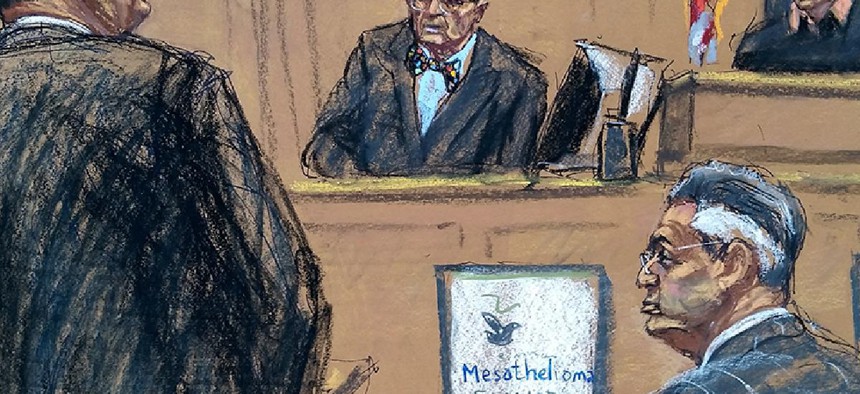On the morning of Tuesday, Nov. 24, a jury of eight men and four women began deliberations in the case that would decide the fate of former Assembly Speaker Sheldon Silver. As the judge gave her final instructions to the jurors, there was a palpable sense of unease in the courtroom from the defense team. Just a day earlier the lead defense attorney, Steven Molo, had delivered a closing argument in an angry and accusatory tone – more like he was quickly running out of time, rather than offering a calm and reasoned counter to the government’s case.
Throughout the roughly two-and-a-half-week trial, the defense had seemed cool, even confident, making their closing argument seem even more desperate. When the jury entered their private room in the back of the court, the defense team and even the defendant himself seemed nervous for the first time. They had officially put their case in the hands of 12 strangers, each with their own experiences and biases. And as anybody who pays attention to politics can attest, being a politician these days doesn’t engender any sympathy from the average New Yorker.
But regardless of the climate, who exactly sits on a jury matters greatly to the outcome of the trial. There have been no extended firsthand accounts of what happened inside the deliberation room during the Silver trial. Until now. City & State spoke exclusively with one of the jurors, who delivered a blow-by-blow account of how the discussions began and ultimately ended with guilty verdicts on all seven counts. Our subject asked that I withhold her name, but she is a married mother of two, and a Manhattan resident with an Ivy League education. For the purposes of telling the story, I will call her “Jane.”
Though Jane referred to her fellow jurors by name in interviews, I have opted not to identify them, with the exception of those who have already been named in the press or who chose to speak publicly shortly after the verdict.
Jane told City & State that the prosecution team, led by Carrie Cohen of the office of the U.S. Attorney for the Southern District of New York, “laid out the case impeccably.” That’s an enormous compliment considering how convoluted the evidence seemed at times.
In contrast, Molo made Jane feel uncomfortable – he stared at people perhaps a few seconds too long, rendering the sustained eye contact unsettling. The defense “didn’t present facts,” she told me, and it was aimed at trying to “fool people.”
She concluded that the entire defense presentation seemed phony. “We are not going to fall for that,” she added, with a snap of her head. “Molo talked down to us and insulted our intelligence.”
Pressed for a more introspective assessment of why she came to her conclusions about Silver’s guilt, Jane paused for a minute or so. “Somebody needs to be made an example of,” she said, finally. “We don’t let people off the hook for crimes they commit because they happen to live in a quote-unquote bad neighborhood. Why would we let him (Silver) off the hook? He was lying in the press. And he was dishonest in his motives for governing. White collar crime cannot be held to a different standard.”
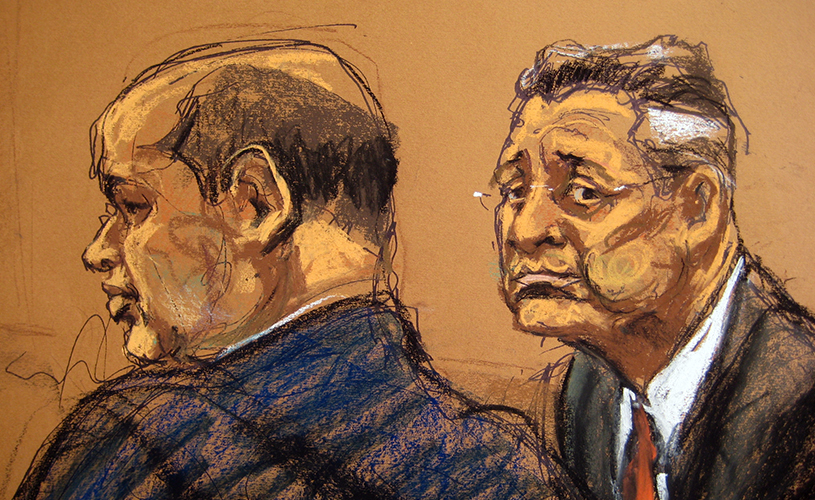
Former Assembly Speaker Sheldon Silver
Day one of the deliberations began in the late morning on the Tuesday before Thanksgiving. And while there were only about two and half days of discussion, they were marred by a series of bizarre requests to the judge in the form of handwritten notes.
“When all 12 jurors walked into the room it was split roughly in half between those who felt Silver was guilty and those who did not,” Jane recounted.
If instructions were followed, it was the first time the 12 jurors had ever discussed the case. They wrote out each of the seven counts on a large whiteboard in the center of the room, and methodically went around the rectangular table taking input from every juror on each count. After about an hour and half of convincing and cajoling, a woman since identified as Arleen Phillips and another male juror were the only holdouts who did not believe Silver was guilty. The male juror, since identified as Bronx taxi driver Kenneth Graham, said little. And according to Jane, “no one really took him seriously.” Graham later claimed he had not questioned Silver’s guilt.
But as the consensus in the room was building to convict, Phillips refused to acquiesce. And she quickly became the focus of the group’s ire.
“It was getting noisy,” Jane said. “Two jurors seemed to be ganging up on her. One of the jurors kept raising her voice.”
After going around the room again, Phillips shut down. She put on her sunglasses and simply stopped engaging with the other jurors. At about 12:40 p.m. she passed her first note to Judge Valerie Caproni.
“I am wondering if there is any way I can be excused from this case,” Phillips wrote, “because I have a different opinion/view so far in this case and it is making me feel very, very uncomfortable … I’m feeling pressured, stressed out … told that I’m not using my common sense, my heart is pounding and my head feels weird. I am so stressed out right now that I can’t even write normally. I don’t feel like I can be myself right now! I need to leave!”
No one else in the room was even aware that Phillips had sent the note, according to Jane.
A short time later, another juror, who was clearly exasperated with Phillips, sent a second note asking for clarification.
“One of the jurors is having difficulty distinguishing whether or not exchanging NYS funds for something in return is illegal,” the juror wrote. “Is there a code of conduct (ethical) which clearly outlines this is this is the case for an Assembly person.”
Outside the jury room in open court, Caproni consulted both the defense and prosecution about how to respond to the notes. She decided to point the jury toward a portion of the charge that had already been read about what constitutes public duty and official action. After calling the 12 jurors out into the courtroom, she reminded them to listen to one another, and to be respectful as they continued their deliberations. The jury was then sent back to their room.
What happened over the next few hours was described by Jane as “some progress,” although Phillips still “had doubts” about the scheme involving Silver and Dr. Robert Taub. Initially most of the jury room agreed that Taub was a sympathetic witness and an honest man, according to Jane, but that view changed over the course of discussions.
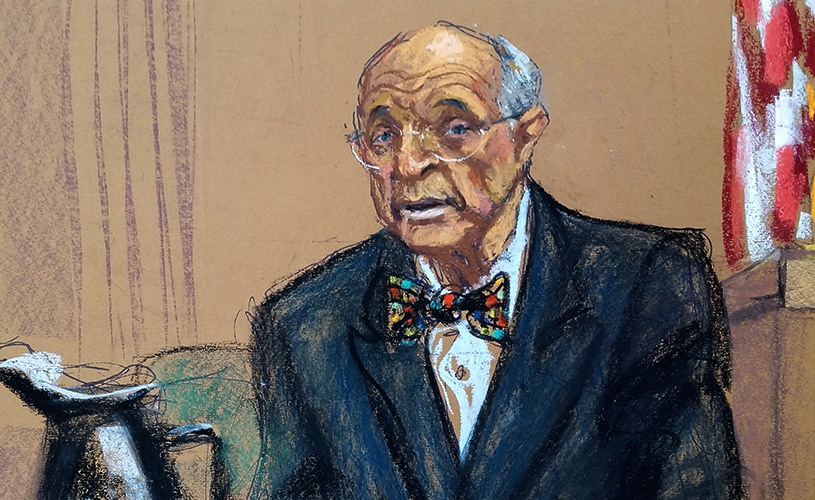
Dr. Robert Taub
At the center of the government’s case were two alleged corruption schemes. Both were presented as illegal quid pro quos: abuses of public power in exchange for monetary kickbacks.
The first scheme involved Silver’s relationship with the 79-year-old Taub, who ran a Columbia University research center for mesothelioma, a rare cancer often associated with asbestos exposure. Since mesothelioma is so uncommon, securing research dollars can be challenging in a medical field where other diseases are far more prevalent and attract greater attention and public health resources. According to Taub’s own testimony, only about 100 new patients are diagnosed with mesothelioma in the New York area annually. By comparison,nearly 14,000 people in New York state are diagnosed with new lung cancer cases in any given year, according to the New York State Department of Health.
Silver knew the bow-tie-wearing Taub through the tightly-knit Orthodox Jewish community rooted on the Lower East Side. They first met in 1984, but it was in 2003 that Taub met with Silver and asked him to convince the law firm of Weitz & Luxenberg to donate money toward his mesothelioma research, according to court documents and testimony. Silver was “working” for Weitz and Luxenberg as “of counsel,” which, in this case, meant that his name was simply associated with the firm. As court testimony later revealed, Silver did very little actual work for the firm, which had long handled personal injury cases. But as the mid-2000s wore on, Weitz & Luxenberg was beginning to develop a specialty niche representing clients who had developed mesothelioma and were now suing the sources of their asbestos exposure. Those lawsuits often resulted in lucrative judgments. The floors at the World Trade Center contained asbestos, so when the towers came down, Lower Manhattan braced for a spike in new mesothelioma cases. Because of a long incubation period, those new cases are expected to peak 10 to 15 years after exposure, which is right about now.
Silver initially turned down Taub’s request for a research donation through Weitz & Luxenberg, according to testimony, but about two weeks later Silver reached out to Taub to ask for mesothelioma patient referrals. Taub began sending patients, who Silver then passed along to Weitz & Luxenberg. For each referral, Silver received a fee from the firm and was guaranteed a portion of successful civil settlements. According to Taub’s testimony, Silver communicated to him that he was “pleased with the referrals.” Taub remained eager to secure more research dollars, so in 2004 Silver suggested he write a letter to the Assembly office requesting state funding.
In 2005 and 2006 Silver was able to deliver two taxpayer-funded grants of $250,000 each, according to the testimony of more than one witness in court. He secured these funds from the 1996 Health Care Reform Act, which was, in essence, a secret slush fund from which Silver could dole out public money with very little oversight. However, the Budget Reform Act, passed a year later in 2007, took away that ability. Thereafter, all grants involving public money had to be more fully disclosed.
After the source of the secret money dried up, Taub testified that Silver made a house call to him one afternoon at Columbia. Claiming he had an appointment in the building, Silver dropped by and explained that he could no longer provide public grants for Taub’s mesothelioma research. Taub was very short on specifics about this meeting, claiming on the witness stand that he didn’t recall the details of the conversation, but he did walk away with the understanding that the Assembly grants were no longer coming his way. Silver had also told Taub not to tell their mutual friend Daniel Chill about the patient referrals. Chill has worked on and off for the state Assembly as outside counsel since 1969. He was never called as a witness.
Taub went on to testify that he still wanted to maintain a good relationship with Silver, so he continued the referrals anyway. He provided the names of roughly 25 patients to Silver over a decade.
During cross-examination, a defense attorney asked Taub, “You did not have an explicit agreement to exchange patients for grants, did you?”
“I did not,” Taub responded.
It didn’t matter. The damage had been done. The government had established an illegal quid pro quo in this scheme – public grant money for patient referrals, which eventually netted Silver more than $3 million.
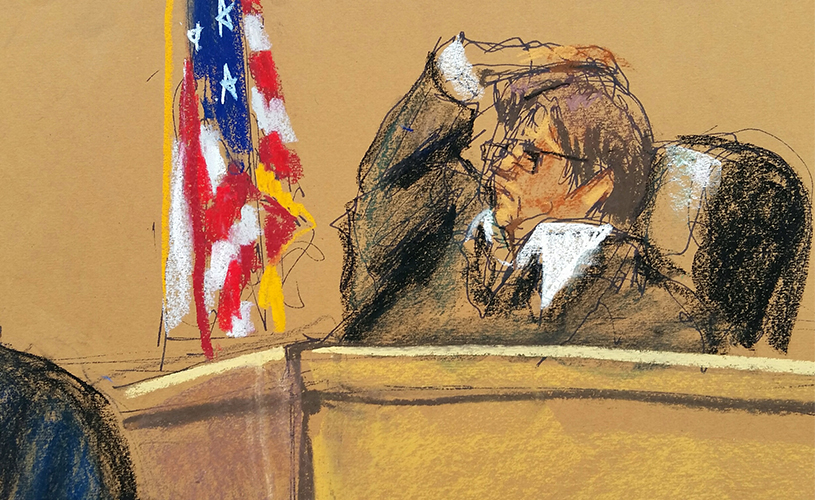
Judge Valerie Caproni
Back in the jury room during the afternoon of the first day of deliberations, Phillips continued to have her doubts about the Taub angle. Group discussions were continuing, but some jurors were starting to give up on convincing Phillips. Jane described the room as a “cacophony,” and a complete “sensory overload.” Jurors were all talking at once, but Phillips didn’t seem to be listening.
A third note was passed to the judge later that afternoon by a different juror, who asked for clarification of counts 5 and 6, which dealt with extortion. While this indicated that the jurors were making headway in reaching a verdict, Phillips appeared to be moving in the opposite direction. Just before deliberations broke for the day without a verdict, Phillips passed yet another note to the judge.
“Can I have a meeting with Judge Caproni after everyone is dismissed?” she asked in the note.
Upon receiving the note, Caproni buried her head in her hand in an exaggerated gesture of frustration. After consulting once again with the defense and prosecution, the judge decided to table the request until the next morning. Phillips would not be getting her one-on-one meeting, nor would she be excused. And the next day would bring a whole new round of high drama.
On Wednesday, Nov. 25, the jury gathered at roughly 9:30 a.m. to resume deliberations. It was the day before Thanksgiving, and Caproni had promised the jurors they could call it quits at noon if they wanted. In the morning they informed Caproni that all were present and they wished to leave at noon, an early sign that no verdict would likely be reached on the second day, either. Next on the agenda was to address Phillips’ request for a meeting with the judge from the night before.
Caproni brought the prosecution and defense teams into the courtroom without the jury present and described her concerns aloud. She was not sure if the other jurors even knew Phillips had requested a meeting. (Indeed, many did not.) Thus, she wanted to respond with caution. Caproni lamented that she was stuck between the 2nd Circuit Court rules governing the sanctity of secrecy during jury deliberations and “a human being who has requested a meeting.”
After both sides had weighed in, Caproni summoned the jury into the courtroom. She told them that no juror should change their mind just because they may be outnumbered. However, she said she could not meet with any one juror individually since the secrecy of jury deliberations “is the cornerstone of our democracy.”
The jury returned to private deliberations, and as the morning wore on the other jurors were once again becoming particularly annoyed with Phillips. Jane recalled that she then spoke up, arguing that they were “never going to get out of here if they continue to antagonize” the holdout. “So,” she said, “let’s hit the reset button.”
Jane then sat down with Phillips one on one and quietly reviewed all the charges. Periodically, two other jurors would come over and check in, but for the most part it was a two-way conversation. While Phillips occasionally nodded in agreement, it seemed clear that she “never got it,” Jane said, at least as far as the first scheme involving Taub was concerned. By the time deliberations ended on Wednesday, Phillips had seemed to come around to recognizing Silver’s criminal liability when it came to the second scheme, which involved kickbacks to Silver from another law firm in exchange for tax work. At noon, the jurors went their separate ways for the Thanksgiving holiday.
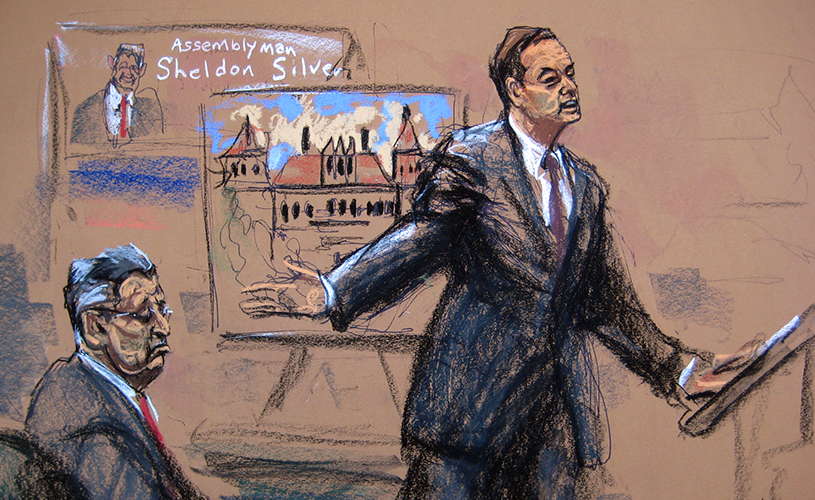
Silver during the trial
The second scheme laid out by the federal government centered on Silver’s referral of wealthy real estate developers to Goldberg & Iryami, a small downtown Manhattan law firm that specializes in tax certiorari. Tax certiorari is the legal review of property tax assessments. After a local government assesses a property’s value, developers hire lawyers to try and get the assessed value lowered in order to reduce the tax burden.
Goldberg & Iryami, the firm at the center of the scheme, was founded by Jay Arthur Goldberg, who served on the New York City Tax Commission during the Koch administration. Goldberg, a childhood friend of Silver’s, also had served as Silver’s Assembly counsel.
Silver received roughly $700,000 over more than a decade for tax certiorari work he referred to the Goldberg firm, according to prosecutors. The biggest client he brought in was Glenwood Management Corporation, a major owner and developer of luxury apartment buildings, mostly in Manhattan. Glenwood had also set up limited liability companies for the individual buildings they owned. These LLCs allowed the company to get around the limitations on legal campaign donations that individuals or corporations can make to politicians. Glenwood has donated more than $10 million to state political campaigns over 10 years, more than any other entity. The company also gave Silver plausible deniability because, according to testimony, Silver claimed that he was receiving fees from Goldberg that were generated by the LLCs and not Glenwood itself, which had interests before the state.
Testifying for the government in exchange for immunity was Dara Iryami, the other half of the Goldberg & Iryami firm. According to Iryami, Silver received 25 percent of the cut from tax reductions she was able to secure for Glenwood’s LLCs, even though Iryami did all the actual work. Silver never disclosed those fees on his annual Assembly financial disclosure forms, according to testimony. Elected officials in New York are permitted to earn outside income as long as it is disclosed publicly. Those laws have been updated several times over the years, and there are still questions about what exactly constitutes “disclosure.” As Assembly speaker, Silver helped negotiate and write those disclosure rules. And through some tortured logic, he and his attorneys maintained that Silver was in compliance with the letter of that law.
When Glenwood eventually learned of the fees Silver was receiving in 2011, executives were “upset and angry,” testified Richard Runes, a top Glenwood lobbyist. But instead of ending the arrangement, Runes said that it was important to Glenwood to maintain a good relationship with the Assembly speaker, so they devised a way to hide the referral fees. A new retainer agreement was drawn up between Glenwood and Goldberg & Iryami that did not mention Silver. With that retainer came a side letter stipulating Silver’s role. The side letter, which was added in January 2012, did not have to be disclosed publicly.
So, the “quid” in this case was the referral fees or kickbacks and the attempts to cover up those fees. The “quo” was a series of actions Silver took on behalf of Glenwood in his official capacity as Assembly speaker.
For example, in the spring of 2011 Glenwood requested a meeting with Silver at the state Capitol. A number of issues before the Assembly directly affected Glenwood’s core business interests, including changes to the rent stabilization laws that were set to expire that June. The 421-a tax break for real estate developers was also set to expire. Runes met with Silver and another Glenwood lobbyist, Brian Meara, at the Capitol on June 6, 2011. According to Runes’ testimony, the Glenwood team made a number of proposals about the housing legislation, although he did not recall them with any specificity. Asked how Silver responded, Runes said, “He didn’t say yes, and he didn’t say no.” However, after all was said and done the final versions of the bills that passed the Legislature and were signed into law left Glenwood “satisfied,” Runes said.
In another instance witnesses testified about the sweetheart loans Glenwood and other developers received through the Public Authorities Control Board, or PACB, which most people in New York probably haven’t heard of, even though the board approves hundreds of millions of dollars in tax-exempt bonds for private developers.
The PACB has five representatives, one each from the minority and majority in both the Senate and the Assembly and one from the governor’s office. All votes by the board must be unanimous. Some of the loans they approved included financing in 2002 of $100 million to build a Glenwood property at 10 Liberty St. in Lower Manhattan. Silver’s proxy on the board signed off on this, in addition to several other Glenwood projects over the years. In fact, from 2000 to 2014 Glenwood received more than $1 billion through the PACB for buildings in New York City. Compare that astounding windfall to the paltry $10 million in campaign contributions Glenwood made to state leaders over that same period, and the donations are like a drop in the bucket – a mere cost of doing business in New York.
During the trial, prosecutors also played a handful of press interviews in which Silver refused to divulge the sources of his outside income but insisted repeatedly that he never represented clients with business before the state. This was, of course, completely untrue. And the claims ultimately helped erode Silver’s credibility with the jury.
During a 2008 radio interview played for the jury, Silver was asked several times about the sources of his outside income. Silver insisted that he represented average people in personal injury cases, and never anyone who had business before the state.
“Whether it’s an auto accident, an asbestos case,” he told the interviewer, “… not sure how much I’m allowed to say.”
The roots of Silver’s relationship with Glenwood run deep. In 1997, Brian Meara, the Glenwood lobbyist, introduced Silver to Leonard Litwin, who owned and operated Glenwood Management. Litwin, Silver and Meara would go to Ratner’s, a Jewish deli on Manhattan’s Lower East Side that has since closed. Litwin is now 101 years old, and was unable to testify at Silver’s trial, so his state of mind had to be explained (often times circumstantially) by other witnesses.
The year Silver met Litwin was a significant one in Albany, although Meara claimed under oath not to remember anything about the 1997 fight over the rent protection laws governing more than a million New York City tenants in rent-stabilized apartments. Tenant advocates, including Michael McKee, the treasurer of the Tenants Political Action Committee, counter that Meara’s claim of not remembering 1997 is “absurd,” since that was the year Silver “sold them out” and “gave away the store.”
In late 1996, Republican State Senate Majority Leader Joe Bruno declared that the city’s rent protection laws should be allowed to expire permanently, and his stance made for a contentious session. The way McKee describes it, in exchange for a six-year extension of the rent protections, Silver agreed to a number of provisions that greatly weakened the rent laws and tenant rights going forward, including requiring tenants to pay rent into an escrow account during disputes with landlords and making it easier for landlords to evict tenants. Perhaps most significantly, vacancy deregulation was enshrined permanently in state law. Vacancy deregulation allows owners of rent-regulated apartments to charge the market rate when rents rise above a certain threshold and the tenants die or move out. Establishing that kind of deregulation for previously protected apartments was what one Democrat described as the "original sin."
Limited vacancy decontrol actually began in 1993, before Silver was speaker, but the events of 1997 made it permanent. Rent protections would eventually be phased out – it was just a question of how quickly. It was a huge gift to the real estate industry to even begin deregulating rent stabilized units in New York City, and one of the biggest beneficiaries was Glenwood Management.
But 1997 wasn’t only the year that Silver was accused of selling out the tenants he always claimed to advocate for. At the same time, Litwin began sending tax certiorari work to the law firm of Jay Arthur Goldberg, Silver’s lifelong friend. This detail was mentioned butnot emphasized by prosecutors during the trial, perhaps because Meara claimed not to remember, or perhaps because Litwin couldn’t testify. But in hindsight, in light of the convictions, they didn’t need to.
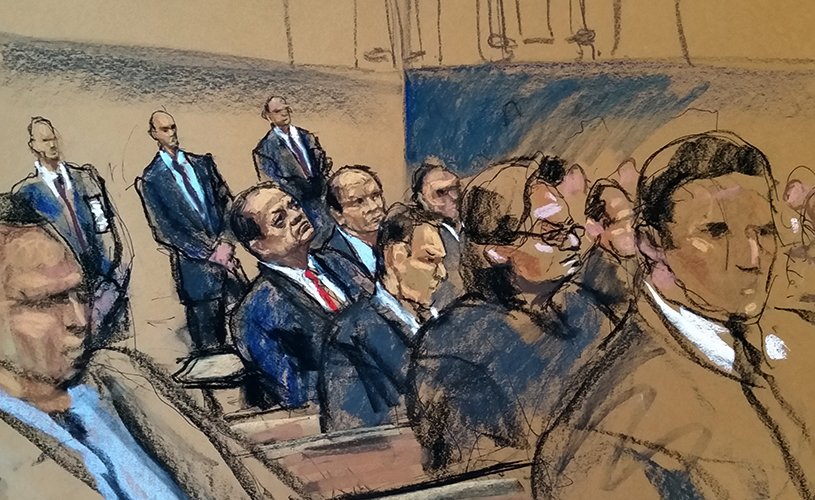
U.S. Attorney Preet Bharara
On Monday, Nov. 30, after the long Thanksgiving weekend, all the parties in the Silver case reconvened in Caproni’s courtroom just before 9:30 a.m. The jury went behind closed doors and soon restarted their deliberations. They didn’t get very far. At 9:35 a.m., juror Kenneth Graham, the taxi driver who had also been holding out, asked to be excused.
“To honorary judge: I, juror #11, no longer wish to participate as a juror on this case,” he wrote in a note to the judge. “I believe there is a conflict of interest that I just learned about. Thank you.”
What followed was a roughly two-hour exchange between the judge, prosecutors, Silver’s lawyers and Graham, all behind closed doors. Two reporters were permitted to listen in on those discussions.
Graham explained that the man who owns his taxi medallion has ties to Silver through synagogue, which he had learned from co-workers at his Bronx garage over the weekend. There was no evidence Graham felt threatened, just uncomfortable.
“It could be a hardship,” Graham reportedly said. “Do you want me to tell you everything? The medallion I lease is from a guy who associates with Silver. It would not be fair to be on this case.”
Caproni interpreted Graham’s concerns as someone who was worried that if he voted to convict Silver, his leased medallion could be at risk. Graham went on to say that the unnamed medallion owner, who has more than 250 medallions, was a man who he sees at the garage but doesn’t really ever talk to. Caproni explained that the law protects Graham from any kind of retaliation. After the conference was over, Graham reluctantly agreed to go inside and resume deliberations if Caproni was ordering him to do so.
“I’ll do my best or whatever,” Graham said, “but I’d prefer not to hear any more.”
Graham returned to the jury room and initially refused to tell the other jurors why he had disappeared for two hours. However, he eventually explained everything. He then announced that he was ready to convict Silver on all counts.
Jane said she continued making progress with Phillips, the lone holdout. What ultimately sealed it was looking at Silver’s old financial disclosure forms, which seemed to make clear to Phillips that Silver “was hiding something.” Jane said a stumbling block for everyone in the beginning was whether Silver actually knew “what he was doing was illegal.” The jurors spent the next few hours discussing the evidence that stuck out to them, including Silver’s interviews in the press in which he clearly lied about representing companies with business before the state.
“He was in the press saying something different than what he was doing,” Jane said.
The jury also concluded that another sign of Silver’s guilt was that he stopped making public money available once he had to disclose it. What was he hiding? They were further swayed by the account of Silver personally visiting Taub when he could no longer make that money available. Taub testified that he never got a reason why the public funds would be drying up, and jurors found that utterly implausible.
“Taub certainly would have asked why,” Jane said. For some jurors, it was this story that helped also seal the entire arrangement between Taub and Silver as something illicit that they both were in on. Why would Silver just show up in person unless he was trying once again to cover his tracks? The jury found Taub’s claims less than credible.
“It’s shady,” Jane concluded. “Most people in the jury room knew nothing about Albany. The thought was that politics in general is corrupt.”
Finally, at about 3 p.m. on that Monday afternoon, Phillips told her fellow jurors, “I’m ready.”
Both Silver and U.S. Attorney Preet Bharara were in the courtroom when the verdicts were announced: guilty on all seven counts. The jury’s work was done. In the biggest test so far of Bharara’s strategy of putting Albany on trial, federal prosecutors had successfully proven Silver to be corrupt.
Some observers have suggested that Silver would have been better off with a bench trial before a single judge instead of a jury of 12 strangers, but experts say all parties would have had to agree to that arrangement, and it is unlikely the government would have allowed it. The U.S. Attorney’s office declined to comment for this article, and would not make Bharara or any of the assistant U.S. attorneys who prosecuted the case available to speak, even on background. Bharara spoke exclusively to two media outlets after the conviction, opting not to hold a press conference after the unprecedented corruption convictions of Silver and then former State Senate Majority Leader Dean Skelos two weeks later. Attempts to reach Phillips and Graham were unsuccessful.
Silver will appeal his conviction. Post-trial motions are due Jan. 18, and the federal government will have 45 days to respond. Silver’s sentencing date has been set for April 13, and he faces up to 20 years in prison, although he could face more than 100 years if the sentences for each count do not run concurrently. After sentencing, Silver’s appeal can go forward; oral arguments would be heard by a three-judge panel from the Second Circuit Court of Appeals, which could be up to a year away.
As for Silver’s chances on appeal, it’s hard to say what will happen. Four of the counts he was convicted on deal with honest services fraud, which has had mixed results in the courts. To begin with, the statute itself has only been on the books since 1988. And in 2010 the U.S. Supreme Court narrowed the definition by vacating part of the conviction against Jeffrey Skilling, the former CEO of Enron, the energy company that imploded in 2001.
Bruno, the former state Senate majority leader, had his 2009 corruption convictions, which were based on an honest services fraud, thrown out. He was subsequently retried on two of those counts, only to be acquitted in 2014.
As reporters rushed out of the courtroom to file stories on Silver’s verdict or go live on camera, his defense attorneys asked to speak privately with members of the jury. They spoke to all 12 jurors for roughly an hour afterwards, a meeting described as “highly unusual.”
The defense team had opted not to call any witnesses, an aggressive strategy intended to send a message to the jury that the prosecutors had simply failed to prove their case. In the meeting, the defense asked if anything would have swayed them toward an acquittal. Some jurors responded that they wanted to hear from Silver himself. Others said they had hoped to hear from character witnesses who could attest to Silver’s lifetime of public service. And at least one juror asked why Silver’s chief of staff in the Assembly, Judy Rapfogel, never testified. Her name was invoked several times during the trial, and she was on the prosecution’s list of potential witnesses, but was never called to the stand.
People close to Silver say the decision not to call character witnesses or put Silver on the stand was strategic.
“Our defense was that we didn’t dispute the facts,” said a person involved with Silver’s defense. “We didn’t dispute that he made introductions, we just said it didn’t constitute criminal conduct under the law.”
Silver’s team understood that the public is fed up with politicians. However, they objected to what they saw as the government portraying legal conduct as somehow sinister. Prosecutors kept trying to make an issue out of the sizable contributions Glenwood and other real estate companies gave to political campaigns, even though such donations are perfectly legal. Or that the government kept making the point that the grants Silver controlled were never subject to audits or peer review. No grants distributed by state officials are subject to that kind of scrutiny, they argued.
At least one attorney also found it strange that a juror would complain that their arguments insulted their intelligence, countering that “jurors would not have spoken to us for as long as they did as a group if they had really thought that.”
Yet the defense team came closer to avoiding a guilty verdict for their client than anyone outside the jury knew. If Phillips had stood her ground and refused to budge, the judge could have declared a mistrial and the government would have been back to square one. This is one reason why defense teams hire jury consultants, to help construct snap psychological profiles of the individuals who will be judging their clients. Silver’s team did this, albeit without much success. In the end, the will of one person on a 12-person jury made all the difference in determining the guilt or innocence of Silver, once considered the most powerful man in state government.
The jury understood the facts, in the view of Silver’s defense team, they just didn’t agree about what the outcome should be. As they walked away from their discussion with the jurors, Silver’s attorney felt that there wasn’t much they could have done differently.
Zack Fink is a political reporter for NY1. He wrote a cover story for City & State on the relationship between Gov. Andrew Cuomo and Gov. Chris Christie in 2014.

